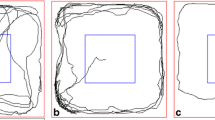Abstract
Gamma (\(\hat \gamma\)) is a recently proposed statistic that quantifies and describes the repetitive patterns of locomotion (locomotor stereotypy) exhibited by amphetamine-treated rats in an open field. The time-course of locomotor stereotypy after 1, 2, 3, and 4 mg/kg amphetamine was investigated in this research. Locomotor stereotypy was often evident during the first observation period after amphetamine. Lower doses of amphetamine produced qualitatively different locomotor stereotypy than higher doses. Rats given higher doses of amphetamine exhibited locomotor stereotypy during the “hyperactivity” phase of the three-phase response produced by higher doses of amphetamine (hyperactivity; absence of locomotions, increased sniffing, biting etc.; hyperactivity). Contrary to expections, rats injected with 2 mg/kg amphetamine exhibited the highest and most sustained increase in\(\hat \gamma\). We conclude that locomotor stereotypy is an important component of the behavioral effects of amphetamine in rats. Whether locomotor stereotypy and focused stereotypy are similar phenomena is still unclear.
Similar content being viewed by others
References
Eilam D, Golani I, Szechtman H (1989) D2 agonist quinpirole induces perseveration of routes and hyperactivity but not perseveration of movements. Brain Res (in press)
Geyer MA, Russo PV, Masten VL (1986) Multivariate assessment of locomotor behavior: pharmacological and behavioral analysis. Pharmacol Biochem Behav 25:277–288
Geyer MA, Russo PV, Segal DS, Kuczenski R (1987) Effects of apomorphine and amphetamine on patterns of locomotor and investigatory behavior in rats. Pharmacol Biochem Behav 28:393–399
Jennrich R, Sampson P, France J (1981) P2V: analysis of variance and covariance including repeated measures. In: Dixon J (ed) BMDP statistical software. University of California Press, Berkeley
Kirk RE (1982) Experimental design: procedures for the behavioral sciences. Brooks/Cole, Belmont
Mueller K, Hollingsworth EM, Cross DR (1989a) Another look at amphetamine-induced stereotyped locomotor activity in rats using a new statistic to measure locomotor stereotypy. Psychopharmacology 97:74–79
Mueller K, Peel JL, Rewey KL (1989b) Effects of caerulein+haloperidol on amphetamine-induced locomotor stereotypy in rats. Life Sci 44:717–724
Schiorring E (1971) Amphetamine-induced selective stimulation of certain behavior items with concurrent inhibition of others in an open field test with rats. Behaviour 39:1–17
Schiorring E (1979) An open field study of stereotyped locomotor activity in amphetamine-treated rats. Psychopharmacology 66:281–287
Segal D (1975) Behavioral characterization ofd- andl-amphetamine: neurochemical implications. Science 190:475–477
Author information
Authors and Affiliations
Rights and permissions
About this article
Cite this article
Mueller, K., Kunko, P.M., Whiteside, D. et al. Time course of amphetamine-induced locomotor stereotypy in an open field. Psychopharmacology 99, 501–507 (1989). https://doi.org/10.1007/BF00589899
Received:
Accepted:
Issue Date:
DOI: https://doi.org/10.1007/BF00589899




